Considering taking up Yoga in your golden years? This guide will help you get started and guide you through simple steps that you can take to make Yoga a part of your everyday life.
Contents
A 2016 study on Yoga revealed that more than 14 million Americans (over 50) had become regular practitioners of ancient art. Yoga has strengthened their body muscles and organs and improved the overall quality of their lives.
If you have passed 50 years of age and are seeking ways to keep yourself fit on a physical, emotional, and mental level, this guide is for you.
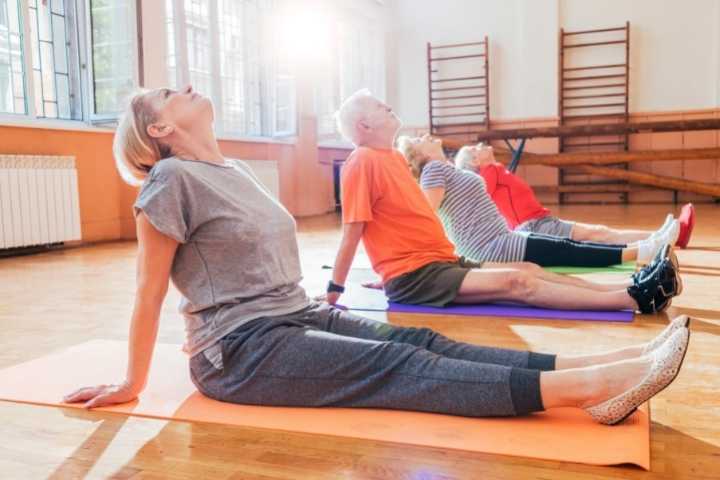
You may also like Is Yoga Good For Osteoporosis?
Yoga and Its Benefits
Yoga is an ancient Indian practice that brings balance and alignment in mind, body, and soul. It encompasses many yogic poses, unique breathwork, meditation, and other exercises that together bring several benefits to the body – even science has backed it several times.
Some of the main benefits of practicing Yoga include
- Strength building
- Mindfulness
- Positive thoughts and attitude
- Clear mind
- Release of emotional, physical, and mental blocks
- Mental calm and inner peace
- Stress reduction
- Reduction/complete removal of anxiety and depression from the body
- Slow aging
- Increased self-confidence
- Increase muscle tone
- Strong immunity
- Stabilized mood
- A happy mind and healthy body
How To Start Practicing Yoga?
To begin your yoga practice, you must first believe that consistent work in this art will bring you extraordinary results. You must remain motivated and start training with yogic postures, especially Surya namaskar or sun salutations, including 12 poses that complete one cycle.
With time, you should introduce more poses into your practice, along with breathwork and meditation. If you continue doing this for even a month, you will feel like a new person entirely.
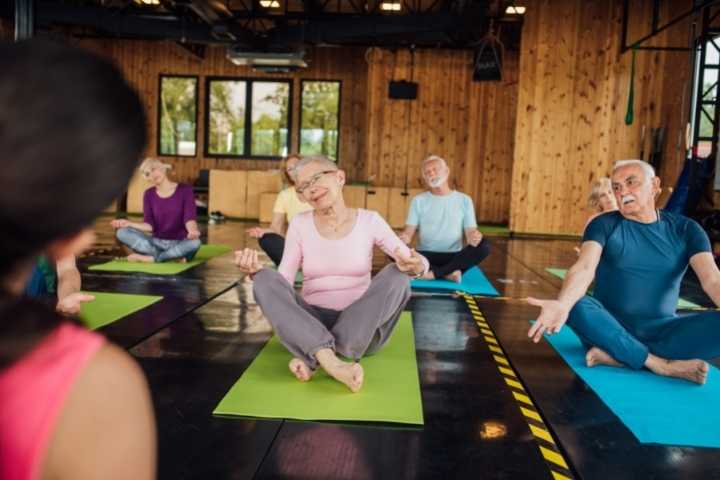
Yoga and The Elderly
Yoga is a science and an art that can be performed by a 5-year old child on the one hand and a 90-year old adult on another.
The most senior yoga practitioner in the world is over 95, and there have been yoga teachers that crossed the 100 mark before they passed away. So, yes, Yoga is beneficial for people of all ages!
B.K.S Iyengar, a world-renowned yoga teacher and founder of the Iyengar style of Yoga, lived up to 95 years of age and practiced yoga postures until the end of his time on the planet.
This shows that this unique practice can be performed and practiced by people of all ages and improves the body and life of older people even more.
Besides, attending a yoga class gets you closer to new people and, thus, new community life. This is very healthy for older adults since they tend to lose touch/connection with their friends and family as they grow older. Having a social connection helps ward off loneliness.
Is It Safe To Practice Yoga as a Senior Citizen?
Yoga is for everyone, and thus, it can be practiced by seniors of every age. It helps improve their illnesses, including digestion, memory and brain function, osteoporosis, depression, anxiety, blood pressure, emotional blocks, and more.
Even though it is known for only enhancing your bodily functions and overall life, we recommend you discuss the same with your medical practitioner and then take your first step towards this practice.
You may also like Yoga After Knee Replacement – A Complete Guide!
Best Yoga Poses for Seniors
Before taking up any physical yoga pose, contact your physician and get their approval first since they know your body inside-out. Once you get a green signal from them, go ahead and begin your yoga practice with the following postures –
Child’s Pose
This is one of the most relaxing and most practiced poses in Yoga. It is usually used as a forward-bending posture, but people often rest in this position when transitioning from a challenging posture.
It starts with getting on your hands and knees and slowly widening the latter along with your hips; tight hips might take it a while to spread. Now, lean your body back and rest your buttocks on your heels, keep your palms towards the floor and keep them extended.
Breathe in this position for at least 30 seconds before returning to the original work. The benefit of this pose is that it opens your hip area and releases stress from your body as you relax.
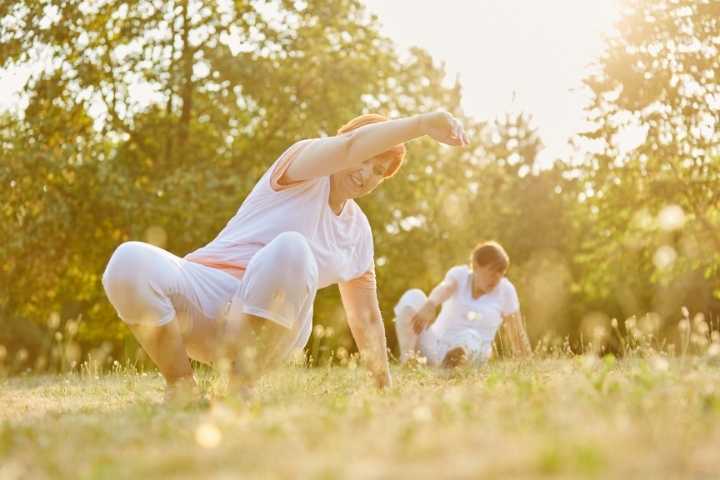
Tree Pose
In this posture, you have to stand straight on your mat and lift your right leg upwards and keep your left leg positioned on the floor. The sole of your right foot should be brought closer to the inner thigh of your left leg and placed over it.
Stay in this position until you cannot balance it anymore. This pose balances your body and calms down your mind.
Chair Pose
In this pose, you start with keeping your feet width apart as you hand straight. Now, bend your knees in a way that parallels your thigh to the ground as if you are sitting on a chair.
Stay in this position for 40 seconds before slowly returning to your original work. This pose strengthens and straightens the spine and builds muscular strength in the leg area.
Cobbler’s Pose
Sit straight back and breathe deeply (relax your body). Now, bring your feet together in a way that allows your soles to face/touch each other. You will have to first bend your knees towards the floor and then bring the feet closer.
Hold the feet with your hands, push your elbows on your thighs and push them towards the bottom. It helps open your hip and improve the blood flow of your spine.
You can always ask your trainer about more poses that you can try and work with them accordingly. Also, keep in mind that Yoga practice should always be done on a proper yoga mat, ALWAYS!
You may also like Best Yoga Headstand Bench
What Forms of Yoga Should Seniors Try?
Yoga can be quite vigorous on the one end and quite soft and comfortable on the other. So when older adults want to learn Yoga, which ends of the spectrum should they tend towards? What seniors should look for is “adaptive yoga.”
The main reason for designing the adaptive yoga form was to make it easier and accessible to more people. By more people, we mean those with injuries, disabilities, and of course, the elderly.
While one can mold the postures in any way they like for their comfort in many other forms of Yoga, below are some practices that can exclusively help senior citizens enhance their health without having to put a lot of effort from their side.
In the sections that follow, we discuss some forms of Yoga that are adaptive in nature.

Gentle Yoga for Seniors
There is a new term introduced in the world of Yoga that’s exclusive to senior citizens – gentle Yoga. This style of Yoga only includes those poses that help deal with age-related issues, such as management of blood pressure, chronic pain in bones and joints, improvement in blood circulation, and reduction in heart problems. The types of poses that form a part of gentle Yoga include
Iyengar Yoga
This yoga form is unique compared to others since it includes a variety of props to maintain the balance and posture of the body. Since one can rely on support to maintain a stance, we believe our elderly will benefit significantly from it.
Iyengar Yoga came into existence because it made body postures safe and easy for people. Practitioners are encouraged to use props like yoga blocks, belts, bolsters, incline boards, chairs, etc., to maintain their balance and improve their postures.
Some of the most-practiced asanas (poses) that can be done with props are mountain pose, Triangle pose, standing cow face, standing forward bend, amongst many others.
Hatha yoga
This is the most traditional form of yoga practice that has been in practice for thousands of years. It thus encompasses all styles and shapes of Yoga and typically involves stretching and breathing.
Surya namaskar, or sun salutation, is a significant part of Hatha Yoga. In this yoga form, you can try many standing, forward bending, and back bending poses. The physical techniques involved in this practice transform one’s body and aura and improve flexibility in the muscles.

You may also like HIIT For Seniors – Is It A Good Idea?
Vini yoga
According to the American Viniyoga Institute, this type of yoga practice gives a sense of individuality to every practitioner and thus, helps them discover their innermost self and allow the transformation that is set to take place.
Many unique and refreshing methods and tools are introduced to people in this type of practice that duly helps them find themselves through the postures and breathwork. It branches out of Hatha Yoga and tailors poses that suit the needs and body of each individual.
It helps the elderly practice their sequences better since the poses can be practiced according to their comfort.
Sivananda Yoga
This is another practice that involves modification of Yoga poses to suit the body type of every individual. This style is entirely appropriate for beginners and, thus, is excellent for senior citizens to undertake.
It follows the principles of proper exercise, proper breathing, proper rest, proper food, and positive thinking to live a healthy and happy life.
Restorative Yoga
It is a slow form of yoga practice where the practitioner doesn’t even have to move a muscle but allows various props to support their body in a way that releases tension and stress.
With proper support and breathing exercises, senior citizens can completely relax in their bodies for about 10 minutes or so and feel rejuvenated and content. Corpse pose with the help of a bolster to support your upper back is an excellent example of restorative Yoga.

Laughter Yoga
Laughter yoga is a modern yoga practice where people voluntarily and intentionally laugh for a prolonged period. Also known as Hasya yoga, it is a therapeutic exercise where senior citizens practice laughter exercises with deep breathing that allows an increased flow of oxygen to the brain that releases feel-good hormones known as endorphins.
It is essential to understand that we become vulnerable to many diseases and illnesses as we grow old. However, we must know that we are strong enough to combat them all if we learn to laugh through them all.
Laughter certainly is the best medicine, and laughter yoga is, thus, the best medication for older people. The exercise is fun-to-do and is curated with stretching and balancing work-outs/yoga postures.
You may also like Simple Tips To Manage Your Weight With Age
Benefits of Laughter Yoga
Some significant benefits of the regular practice of laughter yoga are
- Full-body relaxation is due to the release of feel-good hormones.
- Breaking of negative thought patterns
- Better mood and happy attitude
- Alleviation of anxiety, depression, and other stress-related conditions
- Reduction in joint pains, neck issues, shoulder problems, digestion problems, etc
- Grateful state of mind
- Improved quality of life
- Calm nerves and core muscles
- Balanced blood pressure
- Happiness through emotional networking
- Release of emotional blocks
- Improvement in blood sugar level
- Decreased chances of heart diseases and cardiovascular problems

Chair Yoga
On a personal level, we feel that this is the best form of yoga practice for those who have crossed their 60s. This non-traditional yoga practice involves using a chair as a prop for stretching and exercising purposes.
Chair Yoga is ideal for people who cannot stand in one place for more extended periods or can’t work out on a floor mat. Thus, they use a chair, walls, and other support to balance and support themselves.
It is a blend of gentle yoga movements, asanas, breathing techniques, relaxation, meditation, etc., while sitting on a chair.
Please note that while practicing Chair yoga, you must always remember to have your feet touching the ground to maintain the flow of energy. You can set up your practice by keeping a chair, pillow, cushion, etc., to support your back and other body areas.
Benefits of Chair Yoga
The pros of practicing Chair yoga are many for older adults:
- Better chances of continuing one’s practice due to less falling and loss of balance
- A great alternative yoga practice for the elderly is to reduce pains and discomfort in lower body areas, including hip, calves, legs, feet, buttocks, etc.
- It is a low-impact exercise that helps open muscles and brings flexibility.
- Improves blood circulation of the body
- Improves balance
- Combats and reduces anxiety and depression by relaxing neck and shoulder muscles
- Improves posture

Water Yoga
Water yoga for seniors is another excellent option for the elderly because they can relax while exercising in the pool. Also known as pool yoga, this practice includes many yoga postures and movements done in water, thus, slowing them down.
You will see seniors practicing the postures more comfortably and gently in this form of yoga practice because water helps in supporting body weight.
Since most senior citizens can’t keep their hands underwater for more than a few seconds, most yoga asanas to be practiced in this form include standing poses like Tree pose, mountain pose, warrior pose, etc.
Benefits of water yoga
Some of the significant benefits of water yoga for citizens are compiled below –
- Improved heart and lung function
- Reduced pain in joints and other body parts
- Increased flexibility
- The flow of happy hormones
- Gentle resistance in water helps in building muscle strength.
- Relieve from blood circulatory problems
Mindfulness for Senior
If you are only starting with Yoga, you might not know that it isn’t all about postures and breathwork – it is also the practice of sitting silently and at the moment.
Practicing mindfulness is one of the most critical mental health practices, and thus, it is highly recommended for our senior citizens. Let’s throw some light on mindfulness and its benefits.

You may also like How To Overcome Food Addiction
What Is Mindfulness, and How To Achieve It?
In simple words, mindfulness is the essential human quality where one’s attention is present in the moment and nowhere else. Even though it is very natural for us to understand this, most of us lose our ability to stay grounded and at the moment. The world around us is beautiful, but to soak in the experience of life, we must be here and now!
Due to stressful and traumatic life situations, we subconsciously escape from the present moment and go where we feel better, even if it is not real. However, we tend to stop living our own lives and degrade their value in this motion.
The good thing is that there are several ways for us to achieve it again and continue to live in this state of mind – and this works the same way for seniors.
Deep breathing
We know that we need to breathe to stay alive, but none of us has been taught the correct way to live – Yoga teaches us that! Let’s start with 10 minutes of deep breathing every day, and soon, you will notice that half of your problems will be taken care of naturally.
Meditation
The second best way to become mindful is by regular practice of meditation, and it brings emotional balance, inner peace, and relaxation to the body. There is no right way to meditate, so we will ask you to find a spot, close your eyes, and start breathing.
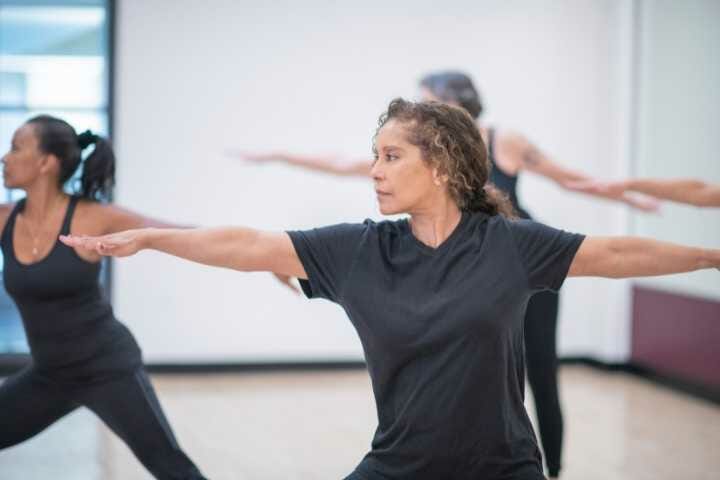
Body Movements
You can move your body from time to time to keep the energy flowing inside you. You do not even have to work out heavily or dance your heart out (even though it is an excellent body movement) or sweat hard – gentle body movements will work miracles for you as well.
Journaling
When you begin writing at least two pages every day, you will start clearing a lot of emotional dumps and, thus, feel lighter and better. Again, like meditation, there is no right or wrong way to journal – start writing whatever comes to your mind, and you will soon find your style. From writing your goals to adding affirmations, journaling will again help you become present at the moment.
You may also like Living With Asthma – A Guide For Seniors
Benefits of Mindfulness
If there is one skill that you should perfect in the next few months, it should be mindfulness. A distracted mind will never let you reach your highest potential – only a focused and happy mind can do that.
Thus, mindfulness is the answer to it. We have also compiled a shortlist of the significant benefits of mindfulness for the elderly.
Relief From Stress, Anxiety, Depression
The number one job of mindfulness is to keep focus and tension away from you. When you naturally live in the present moment, there is no way to be sad. Thus, stress-related thoughts, negative connotations, anxiety, and depression slowly leave your mind and body.
This state of mind and body will balance your blood pressure, reduce the chances of catching any cardiovascular disease and keep you happy and healthy. Seniors, give your utmost attention to building this habit, and you will see how magical life becomes.

Improve Cognitive Functions
Studies have shown that mindfulness increases the volume of gray matter in the brain, responsible for attention, learning, memory, etc. After practicing mindfulness for about a week or so, you will notice that your attention span will increase.
You will be more alert but relaxed at the same time. Your memory will sharpen, and you will reason logically but intuitively.
Stabilized and Happier Mood
This is why we recommend mindfulness to our senior citizens even more – it helps them stay comfortable and away from mood disorders. Even if you do not have any mood disorder, you can go ahead and try this mindfulness because, if nothing else, it will help you stabilize your mood all the time. You will stop ruminating in the past and worrying about the future – your mind will have no option but stay in the moment.
Better Sleep
When we are stressed for an extended period, our cortisol level remains high, and thus, our body continues to be in the fight or flight mode, which even continues when there is no stress or possible danger.
Most seniors also have this inability to unwind themselves, and thus, they cannot sleep or relax due to the biochemistry of their bodies. Mindfulness majorly contributes to calming down one’s nervous system, which in turn helps you sleep better.
You can sit in mindfulness meditation before sleeping to relax your body. Practicing mindfulness has helped remove chronic insomnia for many people, and yes, it has been backed by science.
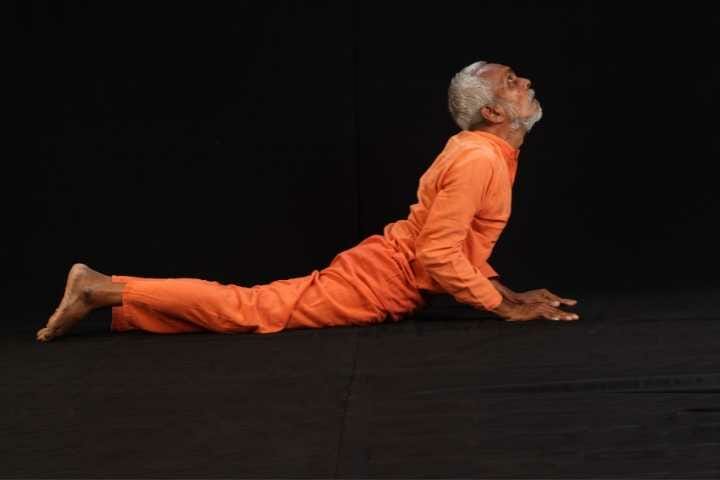
Slow Aging
Now, this one would be a favorite of all seniors, isn’t it? It is true – mindfulness can slow down your biological clock simply because it is an antidote to removing and releasing negative and anxious feelings.
When the cells in our body replicate, the cap-shaped telomeres at the end of our chromosomes wear down with time, leading to cell breakdown and aging.
Stress accelerates this process – this is where mindfulness enters and slows the entire process down, and we start looking much younger and vibrant than before. You can learn more about this here.
You may also like The 8 Best Sports Bras For Seniors
Yoga Is for Everyone
The continuous yoga practice by seniors shows massive improvement in all the parts of their lives and improves their way of living – if you have an elderly practicing yoga at home or in school, you might have noticed the same.
Even though Yoga is for everyone, we would again like to mention that if you feel pain in any part of your body while practicing these exercises, leave it immediately and consult your medical professional. Only they can guide you through it.
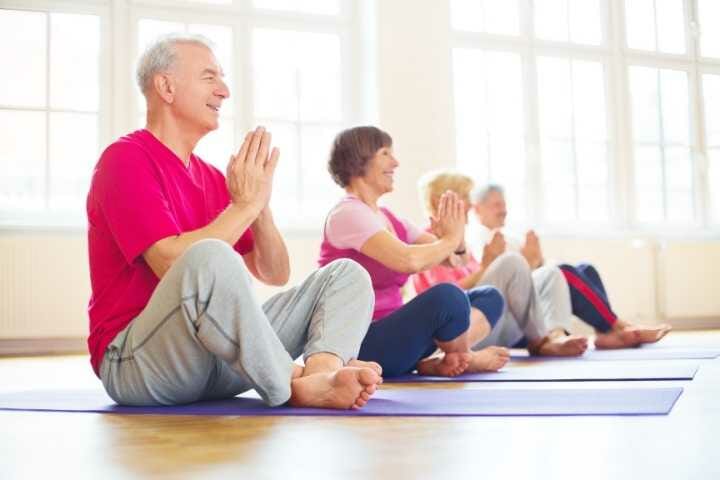
We hope this guide gave you all that you need to know to reap the benefits of this ancient art and practice. If you have any doubts or queries, feel free to drop us a ping, and we will be happy to respond back. And do share this write-up with others who are looking for answers just like this!
